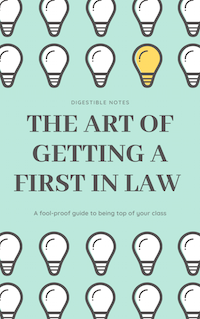Theft
Introduction
⇒ Section 1 of the Theft Act 1968 defines theft: "A person is guilty of theft if he dishonestly appropriates property belonging to another with the intention of permanently depriving the other of it"
⇒ There are 5 elements which will each be explored, although not necessarily in order. A person is guilty of theft if he or she:
- (1) Appropriates;
- (2) Property;
- (3) Belonging to another;
- (4) Dishonestly;
- (5) With an intention permanently to deprive.
⇒ The actus reus of theft is, therefore, appropriating property belonging to another. The mens rea is dishonesty and an intention permanently to deprive.
1. Property
Introduction
⇒ Section 4(1) of the Theft Act 1968 defines property to include "money and all other property, real or personal, including things in action and other intangible property"
- Real property means land
- Personal property is property which is not land
- A thing in action (i.e. a 'chose in action') means a property right that can be claimed in a court action e.g. a debt
- 'Intangible property' includes patents and copyrights → so if you purport to sell someone else's rights under patent, that is theft.
The Art of Getting a First in Law - ONLY £4.99
FOOL-PROOF methods of obtaining top grades
SECRETS your professors won't tell you and your peers don't know
INSIDER TIPS and tricks so you can spend less time studying and land the perfect job
We work really hard to provide you with incredible law notes for free...
The proceeds of this eBook helps us to run the site and keep the service FREE!

Land
⇒ Land cannot be physically stolen, however, you can be guilty of theft of land in three circumstances:
- (1) If the defendant is acting as a trustee (in simple terms, this means they are holding the land for someone else) and sell the land they may be convicted of theft: section 4(2)(a) of the Theft Act 1968
- (2) If the defendant is not in possession of some land and removes items forming part of that land - e.g. taking topsoil, a rose bush, tiles from a roof, crops etc. - they may be convicted of theft. However, note, a person who picks wild mushrooms, flowers, or fruit will not be convicted of theft, so long as the picking is not done "for reward or for sale or other commercial purpose" (s4(3) Theft Act 1968).
- (3) If the defendant has proprietary interest as a tenant and removes fixtures he/she may be convicted of theft. For example, if, as a university student in halls, you take something fixed (e.g. your desk), this will be theft.
Wild Creatures
⇒ A wild creature that is not tamed nor ordinarily kept in captivity (or its carcass) cannot be stolen. Cresswell v DPP [2006] stated, for example, that wild badgers cannot be stolen.
⇒ Exception: a wild creature can be stolen where it has been, or is being, "reduced into possession" (i.e. captured) by or for another person (and has not since been abandoned).
Information
⇒ Information is not property so cannot be stolen. See, for example, the case of Oxford v Moss (1979).
Electricity
⇒ It seems that electricity is not property, although there is a specific offence under section 13 of the Theft Act 1968: “A person who dishonestly uses without due authority, or dishonestly causes to be wasted or diverted, any electricity shall on conviction of indictment be liable to imprisonment for a term not exceeding 5 years".
Dead bodies
⇒ Dead bodies are usually not property (R v Sharpe (1857)) and bodily substances only become property if given to someone else to control (e.g. urine sample to police, as in R v Welsh [1974]).
2. Belonging to another
Title
⇒ Usually whether property belongs to another is easy to establish. However, there are some borderline cases dealt with by the four subsections in section 5 of the Theft Act 1968.
Introduction
⇒ Usually whether property belongs to another is easy to establish. However, there are some borderline cases dealt with by the four subsections in section 5 of the Theft Act 1968.
Section 5(1) Theft Act 1968
⇒ s.5(1): "Property shall be regarded as belonging to any person having possession or control of it, or having in it any proprietary right or interest (not being an equitable interest arising only from an agreement to transfer or grant an interest)".
⇒ This means that property doesn't just belong to the owner (i.e. a person having a 'proprietary right or interest' in property), but property also belongs to anyone with possession or control of property. See, for example, the case of R (Ricketts) v Basildon Magistrates’ Court [2010].
⇒ Note, possession or control does not have to be lawful possession or control (R v Kelly [1998]). See the case of R v Smith [2011].
⇒ Furthermore, an owner can be convicted of theft of his own property (so long as, at the time, the property in question "belonged to another"). See, for example, R v Turner (No. 2) (1971).
Section 5(2) Theft Act 1968
⇒ s5(2): "Where property is subject to a trust, the persons to whom it belongs shall be regarded as including any person having a right to enforce the trust, and an intention to defeat the trust shall be regarded accordingly as an invention to deprive of the property any person having that right".
⇒ In such a case the property shall be regarded as belonging to those entitled to enforce the trust e.g. the Attorney General in the case of charitable trusts.
Section 5(3) Theft Act 1968
⇒ s5(3): "Where a person receives property from or on account of another, and is under an obligation to the other to retain and deal with that property or its proceeds in a particular way, the property or proceeds shall be regarded (as against him) as belonging to the other".
- This subsection deals with the situation where a defendant is given property and is under an obligation to deal with that property in a particular way.
⇒ See the cases of R v Hall [1973] and R v Wain [1995].
Section 5(4) Theft Act 1968
⇒ This section says that if a person gets property by mistake it must be returned. See, for example, the case of Attorney-General’s Reference No 1 of 1983 [1985].
3. Appropriation
Introduction
⇒ Section 3(1) Theft Act 1968: "Any assumption by a person of the rights of an owner amount to an appropriation, and this includes, where he has come by the property (innocently or not) without stealing it, any later assumption of a right to it by keeping or dealing with it as owner".
⇒ The case law has shown appropriation to mean where the defendant has assumed any of the rights of the owner → it is therefore appropriation to touch someone else’s property, offer it for sale, or destroy it.
⇒ See the cases of R v Gomez [1993] and R v Hinks [2001].
4. Intention permanently to deprive
Core Meaning
⇒ The core meaning of the requirement that the defendant must intend to permanently deprive is straightforward.
⇒ The requirement means that borrowing does not normally amount to theft, even if it is borrowed without consent → although borrowing may become theft if it carries on for too long e.g. if you borrow a book from a friend for a long time and do not give it back and treat it as your own, then that will be a crime.
⇒ There must be an intention to permanently deprive.
⇒ However, it may be theft even where the defendant only had conditional intention → if property is taken with the intent to decide at a later stage whether to keep the articles/property, this conditional intention may be acceptable for a charge of theft or attempted theft. But see the case of R v Easom [1971].
Extended meaning: s6 Theft Act 1968
⇒ Section 6 of the Theft Act 1968 provides an extended meaning to the phrase "intending permanently to deprive". The wording of the section is not that clear, but appears that it will be theft in the following cases:
- Where the defendant throws the victim’s taken items away → without section 6 the defendant could have argued that he did not intend to permanently deprive the victim of his items because he would have been happy if the victim found the stolen items.
- Where the defendant sells the items back to the victim → again, without section 6, the defendant could have argued that he did not intend to permanently deprive the victim of the items.
- Where the defendant returns property in an impoverished state it will be theft. This is seen in section 6(1), which states that if the borrowing is "equivalent to an outright taking or disposal" then this amounts to an intention permanently to deprive. For example, if you borrow a football season ticket but don’t return it until the end of the season this will be the same as being permanently taken, and the defendant may be convicted of theft.
- If the defendant gambles the victim’s property or invests it in a risky investment the defendant will be treated as intending to deprive the victim of it.
5. Dishonestly
Introduction
⇒ The meaning of dishonesty is a mixture of statute and common law. The starting point is section 2 of the Theft Act 1968, which sets out various circumstances in which the defendant will not be dishonest.
⇒ The three circumstances determined in section where the defendant will not be dishonest:
- s2(1)(a): The defendant believed he had a right to deprive the owner of the property.
- s2(1)(b) The defendant believed that the owner would consent.
- s2(1)(c) The defendant believed that the owner could not be found.
The common law test for dishonesty
⇒ If the defendant is not acquitted on the basis of section 2(1) the jury will go on to consider the common law test for dishonestly, set out in R v Ghosh [1982]. The Ghosh test previously required the jury to consider two separate questions in deciding whether or not the defendant was dishonest:
- (1) Was what the defendant did dishonest according to the standards of reasonable and honest people?
(2) Would the defendant realise that reasonable and honest people would regard what he/she did as dishonest?- The second limb has now been overruled by the Supreme Court following Ivey (Appellant) v Genting Casinos (UK) Ltd t/a Crockfords (Respondent) [2017]
⇒ As there is now only one limb to the Ghosh test, you now need only answer the first question If the answer to the question is ‘yes’ then the defendant is dishonest. If the answer to the question is ‘no’ then the defendant is not dishonest.
⇒ Note, that even before this change of law, the full test did not need to be used in all cases; only the first question needed to be asked in circumstances where the defendant gives evidence that he or she thought his or her conduct was honest according to the standards of ordinary people.
Law Application Masterclass - ONLY £9.99
Learn how to effortlessly land vacation schemes, training contracts, and pupillages by making your law applications awesome. This eBook is constructed by lawyers and recruiters from the world's leading law firms and barristers' chambers.
✅ 60+ page eBook
✅ Research Methods, Success Secrets, Tips, Tricks, and more!
✅ Help keep Digestible Notes FREE

